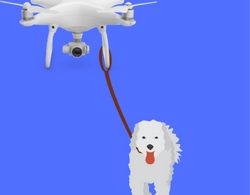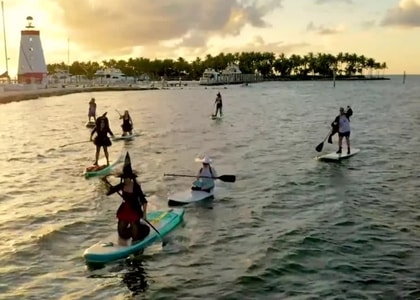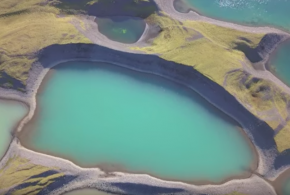Drone Whale Watching in California and Hawaii
Have a look at these perfect and tranquil moments filmed with a DJI Phantom quadcopter. Drone whale watching is a perfect alternative in this case because whales would surely be disturbed by a helicopter or a fixed wing aircraft from this distance. Captain Dave and his team know what they are doing and they bring us amazing footage to view.
Captain Dave Anderson of Capt. Dave’s Dolphin and Whale Safari in Dana Point, California – at great personal risk -, has recently filmed and edited a 5-minute video that contains some of the most beautiful, jaw-dropping, footage ever taken with a drone from the air. The footage contains a huge mega-pod of thousands of common dolphins stampeding, three gray whales migrating together down the coast off San Clemente, California, and heartwarming close-ups of a newborn Humpback whale calf snuggling and playing with its mom, filmed in Maui.
According to N.O.A.A., Southern California has the greatest density of dolphins in the world. “We have pods up to 10,000 strong stretched out for miles like the wildebeests of Africa. Over 400,000 common dolphin alone. We also have the largest concentration of blue whales on earth” as Capt. Dave explains.
“This is the most beautiful and compelling five minute video I have ever put together. I learned so much about these whales and dolphins from this drone footage that it feels like I have entered a new dimension! I have not been this excited about a new technology since we built our underwater viewing pods on our whale watching boat. Drones are going to change how we view the animal world. Wow!”
Capt. Dave had to film this off a small inflatable boat, launching and catching the quadcopter drone by hand where a miss could mean injury to him from the four propeller blades or loss of the drone. He actually lost one drone on takeoff when it nicked his small VHF radio antenna on the 14 foot rigid inflatable he was filming from and it went into the water and sank “faster than he could swim”. Since then he has attached flotation to the skids, or a Water Buoy which would save the footage, but every flight over the water still risks the DJI Phantom 2 quadcopter with a small GoPro HERO3 Black camera on it, as the $1,700 rig is not waterproof and the skids will not keep it upright on the ocean.
“I get so nervous every flight over the water now, after the accident, my hands start shaking,” explains Capt. Dave. “My wife says no more drones if I lose this one. But she said that before I lost the other one. Now that she’s seen what it can do, I think she’s just as hooked as I am”.
“This technology, that offers such steady footage from the air for such a low price and is so easy to fly, is new. This was a ten or twenty thousand dollar copter a few years ago and flying those took a great deal of skill. I can’t wait to see what footage this year will bring with this drone, getting a different perspective on the amazing sightings we already have off Dana Point. There is debate in many states right now about making use of these drones illegal. People are justifiably concerned about invasion of privacy. But it would be a shame to have this new window into a whale’s world taken away.”
Entanglement in fishing gear takes the lives of nearly 1,000 dolphins and whales ever day around the world. Captain Dave formed Orange County’s first whale disentanglement group in 2008 and has been involved in disentangling several whales, including a gray whale named Lily, whose disentanglement in Dana Point Harbor made national headlines. He authored the award-winning book, “Lily, A Gray Whale’s Odyssey”, which won eight awards in 2013.
Special Note From Captain Dave:
Attention any would be whale videographers: please only attempt this if you are extremely familiar with whale behavior as it is illegal to do anything that causes the whales to change their normal behavior with big fines- and the authorities do watch YouTube. Different areas have different laws on approaching whales. I am a whale watch captain with nearly 20 years of experience. All laws were obeyed by us during filming. In Maui we sat watching whales from a distance for hours before they moved closer to us. You can never approach them there closer than 100 yards. The Mom and calf as you can see in the film were completely undisturbed by the small drone. NOAA is currently reviewing drones and may create laws or guidelines for using them around whales.
Thank you Captain Dave, much respect from Dronethusiast. He is a perfect example of a well prepared, passionate quad pilot with a great cause. Plus he creates footage that warms our hearts.
Source: Dolphin Safari Youtube ChannelDrone Whale Watching in California and Hawaii by Captain Dave and Capt. Dave's Dolphin and Whale Safari in Dana Point, California and Maui, Hawaii.






I’m curious how no local laws were violated, when the NOAA web page clearly states that whales in Hawai’i may not be approached by air closer than 1000 meters.
As an FAA Certified Remote Airman, I too would love whale shots from above, but was quickly curbed when discussing this with other photo pros on Maui.
Could you refer me to a contact at NOAA so I can begin the process of gaining this flight authorization?
Mahalo!
It’s a 1000 feet not meters.
Still, you’re max. altitude is 400ft which would render any possibility to fly over whales illegal.
I realize this conversation is 3 years old, but I just checked the NOAA website today. The 1,000 foot minimum altitude is for MANNED aircraft (helicopters, airplanes). See the copy & paste from fisheries.noaa.gov below:
“Maintain a 1,000-foot minimum altitude when viewing marine mammals from the air in manned aircraft (e.g., helicopters, airplanes). Federal law requires aircraft to fly no lower than 1,000 feet above humpback whales in Hawaii and 1,500 feet above North Atlantic right whales throughout U.S. waters.”
“Avoid buzzing, hovering, landing, taking off, or taxiing near marine mammals (on land or in the water), as these actions may alter animal behavior.”
“Avoid flying drones, or unmanned aircraft systems (UAS), near animals. The noise and close proximity of drones can harass the animals and cause stress.”
“NOAA Fisheries is currently developing national guidance for drone (or UAS) operations targeting marine mammals and sea turtles. Until then, NOAA Fisheries reminds the public that dolphins, whales, seals, and sea lions are protected species and harming or disturbing them can be a violation of federal law.”
This seems to clearly separate drones from manned aircraft. If someone has something contradicting this, please post.